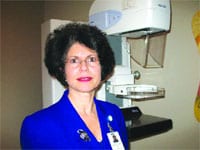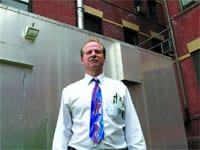Breast Practices Government Task Force’s Mammogram Advice Stirs Controversy
The statistics speak for themselves.
In the mid-’70s, the five-year survival rate after a diagnosis of breast cancer was 75{06cf2b9696b159f874511d23dbc893eb1ac83014175ed30550cfff22781411e5}. Today, it’s 89{06cf2b9696b159f874511d23dbc893eb1ac83014175ed30550cfff22781411e5}.
Many factors have contributed to that startling improvement, including more effective surgical techniques and better imaging tools to identify cancerous cells. But a long-time campaign by cancer experts encouraging women to be screened with mammograms at younger ages has also been a factor in detecting cancer in the early stages, when treatment is most effective.
Which is why a federal government panel caused such waves recently when it recommended that women hold off on annual mammograms until age 50, not age 40, as is currently recommended by the medical community.
“We still endorse the American Cancer Society guidelines to have yearly screenings starting at age 40, with no upper age limit,” said Dr. Grace Makari-Judson, medical director of Baystate Health’s Comprehensive Breast Center in Springfield. “There’s clear evidence from more than 40 years of research that screening with mammograms reduces the risk of death from breast cancer whether it’s in the 40s, 50s, 60s, or older.”
However, Dr. Diana Petitti, vice chair of the U.S. Preventive Services Task Force, which issued the new government guidelines, said that “the benefits are less and the harms are greater when screening starts in the 40s.”
The panel of doctors and scientists concluded that getting screened for breast cancer so early and often is harmful, triggering too many false alarms and unneeded biopsies without substantially boosting women’s odds of surviving the disease. It instead called for mammograms every other year between ages 50 and 74 for all but high-risk women, but did not recommend them at age 75 and up. The task force also declared that the value of breast exams by doctors is unknown, while breast self-exams are of no value.
At the heart of the panel’s recommendation is a simple cost-benefit calculation. “The issue is that you need to screen more women in their 40s to save one life,” Makari-Judson explained. “You need to screen 400 women in their 60s to save one life, 1,300 women in their 50s to save one life, and 1,900 in their 40s to save one life. At any age, you’re reducing the risk of death, but you have to screen more younger women to save lives.”
The message many women, especially those who have contracted breast cancer before age 50, saw in the government recommendation was borderline offensive — the idea that, at some point, it may be too costly and inconvenient to save one life. But Makari-Judson argues that the current ACS screening standards are one important facet of a multi-layered effort that has been reducing breast cancer death rates by about 2{06cf2b9696b159f874511d23dbc893eb1ac83014175ed30550cfff22781411e5} to 3{06cf2b9696b159f874511d23dbc893eb1ac83014175ed30550cfff22781411e5} per year over the past decade. In other words, those ‘one life saved’ figures add up.
Perhaps that’s why response from leading cancer-prevention advocates was quick and firm. “This is one screening test I recommend unequivocally, and would recommend to any woman 40 and over,” said Dr. Otis Brawley, chief medical officer of the ACS, in a prepared statement.
Dr. Len Lichtenfeld, the society’s deputy chief medical officer, chimed in as well. “Our concern is that, as a result of that confusion, women may elect not to get screened at all. And that, to me, would be a serious problem.”
Key Disagreements
Dr. Steven Schonholz, medical director of Mercy Medical Center’s Breast Care Center, also questioned the panel’s recommendations.
“The typical guideline is that somebody should get their pre-screening mammogram at age 35; that’s called a baseline,” Schonholz explained. “Then mammograms start at age 40 and are routine every year after that.”
Family history, which is known to influence risk of cancer, might alter that schedule somewhat, he noted. Specifically, if a woman’s mother or sister was diagnosed with breast cancer at age 45, doctors might recommend annual screenings at age 35.
Interestingly, he said it can take almost 10 years between the time cancerous cells start developing and when they’re detectable on a mammogram. This isn’t commonly known, Schonholz said, so women don’t know how to react when a mammogram picks up cancer. “They say, ‘oh my God, can you do surgery on me immediately?’ I say, ‘how long do you think that’s been there?’ It’s clear that it’s not spreading, just getting large enough to be identified.”
Scholholz’s disagreements with the panel don’t stop there, but extend to the task force’s failure to recommend mammograms after age 75. “Cancer risk goes up as you age,” he said. “It doesn’t make any sense to stop. Plenty of papers have shown that you increase survival by detecting these cancers sooner than later, at any age.”
Makari-Judson also took issue with the panel’s recommendation to focus mainly on high-risk women, noting that the Comprehensive Breast Center has a high-risk screening program targeting women with a family history or other risk factors, giving them guidelines for screening, lifestyle strategies, and risk reduction.
“But the bottom line is that 70{06cf2b9696b159f874511d23dbc893eb1ac83014175ed30550cfff22781411e5} of women diagnosed with breast cancer have no identifiable risk factor other than their age,” she said. “So we cannot limit mammograms to high-risk women only — not with the tools we have today.”
Another contention involves the panel’s advice discouraging women to conduct breast self-exams. “It’s reasonable for women to be aware of changes in their breasts and report them to their physicians,” Makari-Judson said. “We recommend that women be aware of the signs and symptoms of breast cancer. If they are comfortable with breast exams, I certainly encourage them, if not necessarily the monthly, regimented, feel-guilty-if-you-don’t-do-it breast self-exams.”
Ripple Effect?
Although he’s convinced of a track record supporting early mammograms, Schonholz worries that even a non-binding government recommendation could influence how public insurers cover the test.
“The guidelines they put out said to speak to your doctor and see if he recommends screening being done earlier,” Schonholz said. “But that becomes an issue if the government isn’t going to pay for screenings before age 50. Leaving it up to the patient’s physician doesn’t mean they’ll cover the test.”
“It’s a government panel, so the concern is that they might influence insurers to change their coverage for mammography,” Makari-Judson agreed. “But they have to recognize that the specialty societies — the American Cancer Society, the American College of Surgeons, the American College of Obstetrics and Gynecology, the American College of Radiologists — all came out firmly against these guidelines. The panel represents a different perspective, coming from a public-health, epidemiological point of view, but its not the perspective of breast-cancer specialists or clinicians who care for women with breast cancer.”
The task force stressed the trauma of putting someone through a biopsy triggered by a false screening, but Schonholz argues that biopsies take about a half-hour and are not painful.
“You have a biopsy because something has changed, something is suspicious,” he said, noting that 80{06cf2b9696b159f874511d23dbc893eb1ac83014175ed30550cfff22781411e5} of biopsies turn out normal, while 20{06cf2b9696b159f874511d23dbc893eb1ac83014175ed30550cfff22781411e5} reveal cancer. “I would rather have one of my patients undergo a biopsy and find out it’s nothing than waiting until it’s definitely cancer.”
Schonholz said the task force is essentially telling the public that it’s acceptable to miss early cancer readings in many women. “Why wait to identify those cancers extremely early, even as pre-cancer, when it hasn’t turned to cancer yet, and treat these women?” he asked. “The mortality rate has decreased because we’re picking up cancer earlier. Somehow, they took the same information and tried to twist it around a little bit.”
Makari-Judson says the task force, which said it wanted to reduce the anxiety of cancer screenings and false alarms, is only creating more uncertainty and fear among women.
“There’s been a lot of confusion about this report, misinterpretations of the report,” she said. “That’s why we need to get the right message out.”
It’s a message cancer experts have stuck with for more than a decade, and they’re not changing their minds.



Comments are closed.